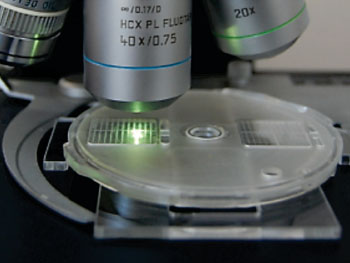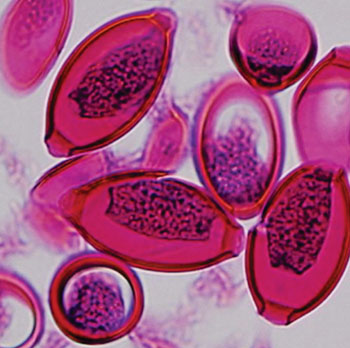Device Diagnostics of Fixed Soil-Transmitted Helminth Infection Assessed
|
By LabMedica International staff writers Posted on 26 Apr 2015 |

Image: The Mini-FLOTAC device for examining stool samples for helminths (Photo courtesy of Public Health Laboratory Ivo de Carneri).

Image: Trichuris trichiura eggs inside a female worm from an infected individual (Photo courtesy of New York University).
Kato-Katz is a widely used method for the diagnosis of soil-transmitted helminth infection, but fecal samples cannot be preserved, and hence, should be processed on the day of collection and examined under a microscope within 60 minutes of slide preparation.
The possibility of collecting fecal specimens in the field, adding a fixative, and analyzing the samples several days later in a central laboratory could overcome the time limitation of working on fresh samples, and hence improve the easiness and the quality of soil-transmitted helminthiasis diagnosis.
Scientists at the Swiss Tropical and Public Health Institute (Basel, Switzerland) and their colleagues enrolled 41 children and their stool samples were subjected on the day of collection to a single Kato-Katz thick smear and Mini-FLOTAC examination. Twelve aliquots of stool were fixed in 5% formalin and subsequently examined by Mini-FLOTAC up to 31 days after collection. The study was carried out in late 2013 on Pemba Island (Tanzania).
The combined results from Kato-Katz and Mini-FLOTAC revealed that 100% of children were positive for Trichuris trichiura, 85% for Ascaris lumbricoides, and 54% for hookworm. Kato-Katz and Mini-FLOTAC techniques found similar prevalence estimates for A. lumbricoides (85% versus 76%), T. trichiura (98% versus 100%), and hookworm (42% versus 51%). The mean eggs per gram of stool (EPG) according to Kato-Katz and Mini-FLOTAC was 12,075 and 11,679 for A. lumbricoides, 1,074 and 1,592 for T. trichiura, and 255 and 220 for hookworm, respectively. The mean EPG from day 1 to 31 of fixation was stable for A. lumbricoides and T. trichiura, but gradually declined for hookworm, starting at day 15.
The authors conclude that for a qualitative diagnosis of soil-transmitted helminth infection, stool samples can be fixed in 5% formalin for at least 30 days. However, for an accurate quantitative diagnosis of hookworm, they suggest a limit of 15 days of preservation. Their results have direct implication for integrating soil-transmitted helminthiasis into transmission assessment surveys for lymphatic filariasis. The study was published on April 7, 2015, in the journal Public Library of Science Neglected Tropical Diseases.
Related Links:
Swiss Tropical and Public Health Institute
The possibility of collecting fecal specimens in the field, adding a fixative, and analyzing the samples several days later in a central laboratory could overcome the time limitation of working on fresh samples, and hence improve the easiness and the quality of soil-transmitted helminthiasis diagnosis.
Scientists at the Swiss Tropical and Public Health Institute (Basel, Switzerland) and their colleagues enrolled 41 children and their stool samples were subjected on the day of collection to a single Kato-Katz thick smear and Mini-FLOTAC examination. Twelve aliquots of stool were fixed in 5% formalin and subsequently examined by Mini-FLOTAC up to 31 days after collection. The study was carried out in late 2013 on Pemba Island (Tanzania).
The combined results from Kato-Katz and Mini-FLOTAC revealed that 100% of children were positive for Trichuris trichiura, 85% for Ascaris lumbricoides, and 54% for hookworm. Kato-Katz and Mini-FLOTAC techniques found similar prevalence estimates for A. lumbricoides (85% versus 76%), T. trichiura (98% versus 100%), and hookworm (42% versus 51%). The mean eggs per gram of stool (EPG) according to Kato-Katz and Mini-FLOTAC was 12,075 and 11,679 for A. lumbricoides, 1,074 and 1,592 for T. trichiura, and 255 and 220 for hookworm, respectively. The mean EPG from day 1 to 31 of fixation was stable for A. lumbricoides and T. trichiura, but gradually declined for hookworm, starting at day 15.
The authors conclude that for a qualitative diagnosis of soil-transmitted helminth infection, stool samples can be fixed in 5% formalin for at least 30 days. However, for an accurate quantitative diagnosis of hookworm, they suggest a limit of 15 days of preservation. Their results have direct implication for integrating soil-transmitted helminthiasis into transmission assessment surveys for lymphatic filariasis. The study was published on April 7, 2015, in the journal Public Library of Science Neglected Tropical Diseases.
Related Links:
Swiss Tropical and Public Health Institute
Latest Microbiology News
- Handheld Device Deliver Low-Cost TB Results in Less Than One Hour
- New AI-Based Method Improves Diagnosis of Drug-Resistant Infections
- Breakthrough Diagnostic Technology Identifies Bacterial Infections with Almost 100% Accuracy within Three Hours
- Innovative ID/AST System to Help Diagnose Infectious Diseases and Combat AMR
- Gastrointestinal Panel Delivers Rapid Detection of Five Common Bacterial Pathogens for Outpatient Use
- Rapid PCR Testing in ICU Improves Antibiotic Stewardship
- Unique Genetic Signature Predicts Drug Resistance in Bacteria
- Unique Barcoding System Tracks Pneumonia-Causing Bacteria as They Infect Blood Stream
- Rapid Sepsis Diagnostic Test Demonstrates Improved Patient Care and Cost Savings in Hospital Application
- Rapid Diagnostic System to Detect Neonatal Sepsis Within Hours
- Novel Test to Diagnose Bacterial Pneumonia Directly from Whole Blood
- Interferon-γ Release Assay Effective in Patients with COPD Complicated with Pulmonary Tuberculosis
- New Point of Care Tests to Help Reduce Overuse of Antibiotics
- 30-Minute Sepsis Test Differentiates Bacterial Infections, Viral Infections, and Noninfectious Disease
- CRISPR-TB Blood Test to Enable Early Disease Diagnosis and Public Screening
- Syndromic Panel Provides Fast Answers for Outpatient Diagnosis of Gastrointestinal Conditions
Channels
Clinical Chemistry
view channel
Carbon Nanotubes Help Build Highly Accurate Sensors for Continuous Health Monitoring
Current sensors can measure various health indicators, such as blood glucose levels, in the body. However, there is a need to develop more accurate and sensitive sensor materials that can detect lower... Read more
Paper-Based Device Boosts HIV Test Accuracy from Dried Blood Samples
In regions where access to clinics for routine blood tests presents financial and logistical obstacles, HIV patients are increasingly able to collect and send a drop of blood using paper-based devices... Read moreMolecular Diagnostics
view channel
RNA-Based Blood Test Detects Preeclampsia Risk Months Before Symptoms
Preeclampsia remains a major cause of maternal morbidity and mortality, as well as preterm births. Despite current guidelines that aim to identify pregnant women at increased risk of preeclampsia using... Read more
First Of Its Kind Test Uses microRNAs to Predict Toxicity from Cancer Therapy
Many men with early-stage prostate cancer receive stereotactic body radiotherapy (SBRT), a highly precise form of radiation treatment that is completed in just five sessions. Compared to traditional radiation,... Read moreNovel Cell-Based Assay Provides Sensitive and Specific Autoantibody Detection in Demyelination
Anti-myelin-associated glycoprotein (MAG) antibodies serve as markers for an autoimmune demyelinating disorder that affects the peripheral nervous system, leading to sensory impairment. Anti-MAG-IgM antibodies... Read moreHematology
view channel
New Scoring System Predicts Risk of Developing Cancer from Common Blood Disorder
Clonal cytopenia of undetermined significance (CCUS) is a blood disorder commonly found in older adults, characterized by mutations in blood cells and a low blood count, but without any obvious cause or... Read more
Non-Invasive Prenatal Test for Fetal RhD Status Demonstrates 100% Accuracy
In the United States, approximately 15% of pregnant individuals are RhD-negative. However, in about 40% of these cases, the fetus is also RhD-negative, making the administration of RhoGAM unnecessary.... Read moreImmunology
view channel
Stem Cell Test Predicts Treatment Outcome for Patients with Platinum-Resistant Ovarian Cancer
Epithelial ovarian cancer frequently responds to chemotherapy initially, but eventually, the tumor develops resistance to the therapy, leading to regrowth. This resistance is partially due to the activation... Read more
Machine Learning-Enabled Blood Test Predicts Immunotherapy Response in Lymphoma Patients
Chimeric antigen receptor (CAR) T-cell therapy has emerged as one of the most promising recent developments in the treatment of blood cancers. However, over half of non-Hodgkin lymphoma (NHL) patients... Read morePathology
view channel
Advanced Imaging Reveals Mechanisms Causing Autoimmune Disease
Myasthenia gravis, an autoimmune disease, leads to muscle weakness that can affect a range of muscles, including those needed for basic actions like blinking, smiling, or moving. Researchers have long... Read more
AI Model Effectively Predicts Patient Outcomes in Common Lung Cancer Type
Lung adenocarcinoma, the most common form of non-small cell lung cancer (NSCLC), typically adopts one of six distinct growth patterns, often combining multiple patterns within a single tumor.... Read moreTechnology
view channel
Pain-On-A-Chip Microfluidic Device Determines Types of Chronic Pain from Blood Samples
Chronic pain is a widespread condition that remains difficult to manage, and existing clinical methods for its treatment rely largely on self-reporting, which can be subjective and especially problematic... Read more
Innovative, Label-Free Ratiometric Fluorosensor Enables More Sensitive Viral RNA Detection
Viruses present a major global health risk, as demonstrated by recent pandemics, making early detection and identification essential for preventing new outbreaks. While traditional detection methods are... Read moreIndustry
view channel
Cepheid and Oxford Nanopore Technologies Partner on Advancing Automated Sequencing-Based Solutions
Cepheid (Sunnyvale, CA, USA), a leading molecular diagnostics company, and Oxford Nanopore Technologies (Oxford, UK), the company behind a new generation of sequencing-based molecular analysis technologies,... Read more
Grifols and Tecan’s IBL Collaborate on Advanced Biomarker Panels
Grifols (Barcelona, Spain), one of the world’s leading producers of plasma-derived medicines and innovative diagnostic solutions, is expanding its offer in clinical diagnostics through a strategic partnership... Read more























